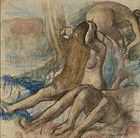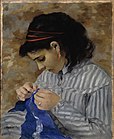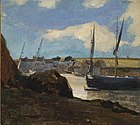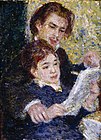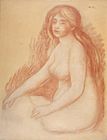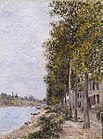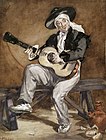La Pausa
La Pausa is a large detached
Situated above the village of Roquebrune, the house enjoys views toward Menton and the French border with Italy on one side, and Monaco on the other.[3] Its name refers to the legend that Mary Magdalene "paused" near here on her journey from Jerusalem following the crucifixion of Jesus.[3][4]
Coco Chanel
Chanel bought the five-acre plot on which La Pausa was built for 1.8 million

The design of the house modelled on the 12th-century convent-orphanage in Aubazines, in the department of Corrèze, which Chanel spent her childhood. A stone staircase leads up from the main entrance hall and a cloister encloses a courtyard.[4] A design of five windows is repeated throughout the house, in tribute to Chanel's perfume, Chanel No. 5.[4] Chanel ordered more than 20,000 curved tiles to be hand-made for the roof, and furnished the house sparsely in shades of white and beige. Each bathroom has a servants' entrance.[4] Chanel would take Le Train Bleu from Paris every month to inspect the progress of the building.[8] If Chanel was unable to make the trip, local craftsmen would be sent to Paris to meet her.[8]
The colour scheme of the house was beige, which included a beige piano.[8] Chanel may have been assisted in her design of the interior of La Pausa by Stéphane Boudin, the president of the interior design firm Maison Jansen.[8]

The central villa is 10,000 sq ft (930 m2) in size, with two smaller villas built for guests.[4][6] The main house consists of seven bedrooms, with three living rooms, a dining room, two kitchens, and staff quarters.[4] Streitz had previously restored another local villa for Chanel's friend, Count Jean de Segonzac.[6]
La Pausa contains three wings that face onto a shaded courtyard, with the rooms containing large fireplaces.[6] The rooms were filled by Chanel with 16th-century English oak furniture, given to her by the Duke of Westminster; English oak was also used for floors and panelling.[6] The large reception rooms were lit by wrought-iron chandeliers from Spain.[9]
The poet Pierre Reverdy stayed at La Pausa for long periods during the 1930s, and the poet Paul Iribe, Chanel's lover, collapsed and died while playing tennis with Chanel at La Pausa in 1935.[6] Guests of Chanel's at La Pausa included Igor Stravinsky, Pablo Picasso, Salvador Dalí and Luchino Visconti.[4]
La Pausa was profiled by American Vogue magazine in 1938, with the garden described as containing "groves of orange trees, great slopes of lavender, masses of purple iris, and huge clusters of climbing roses."[4] Twenty olive trees from Antibes were replanted in the garden.[8] The designer Roderick Cameron said that at La Pausa, Chanel was the first to cultivate lavender and other flora previously regarded as "poor plants".[9]
The architect of La Pausa, Robert Streitz, was a member of the
The design of La Pausa also influenced Chanel's fashion designs, with her collections evoking the pink and grey palettes of the house and landscape.[11] In 2007 Chanel released a perfume inspired by La Pausa, 28 La Pausa, as part of their "Les Exclusifs" collection.[4] It was created by Chanel's perfumer Jacques Polge.[4]
Emery and Wendy Reves

Chanel sold La Pausa in 1953 to the Hungarian émigré publisher
Other notable
Art collection, Dallas Museum of Art
Emery and Wendy Reves created an important collection of
Following Emery Reves's death in 1981, the Dallas Museum of Art in the United States approached Wendy Reves knowing that there was a possibility that her art collection at La Pausa might be given to a museum.[17] In exchange for the 1985 donation Reves insisted that the museum recreate six of the principal rooms at La Pausa, and display the collection there as she had arranged it.[17] The collection of 1,400 objet d'art is displayed at the museum as the Wendy and Emery Reves Collection in a reconstruction of five rooms from La Pausa.[18] The villa's central courtyard and patio were reconstructed at the museum along with the villa's dining room, library, salon, bedroom, and hall,[18] situated in a purpose built 16,500-square-foot wing designed by architect Edward Larrabee Barnes.[18] Wendy Reves also donated $3 million to the College of William and Mary in Williamsburg, Virginia, to establish the Reves Center for International Studies, and directed that the Reves Foundation benefit that college with 40 percent of annual endowment funding. She also arranged for herself and her husband to be buried at William and Mary.[19]
21st century
Wendy Reves continued to occupy the house until her death in 2007.[4] She bequeathed the Reves Foundation including the villa and its contents to the Dallas Museum of Art (which received the largest part), as well as to several charities, and the College of Williams and Mary. La Pausa was closed up after her death;[4] in 2013 the house was described as requiring modernisation, needing new heating, electrical, and plumbing systems, as well as renovations to the kitchen and bathrooms.[4] Repairs were also required to the stone steps and road leading to the house.[4]
Following Reves's death, La Pausa was put up for sale, with the sale of items from the house to benefit the Reves Foundation.[16] In 2012 La Pausa was withdrawn from sale by Sotheby's due to pending litigation.[4] After the legal problems were resolved, Knight Frank put La Pausa up for sale in May 2013 for 40 million euros.[4] In 2013 the French ambassador to Monaco, Hugues Moret, said of the sale that La Pausa was "part of France's heritage," adding that "We have to find a way to keep it in the family."[4]
The villa was bought by the
Works from the Wendy and Emery Reves Collection
-
Paul Cézanne, Still Life with Apples, a Bottle and a Milk Pot, 1900–06
-
Paul Cézanne, Still Life with Carafe, Milk Can, Bowl, and Orange, 1879–80
-
Gustave Courbet, Portrait of Jongkind
-
Gustave Courbet, Portrait of Regis Courbet, the Artist's Father, 1848–1849
-
Gustave Courbet, Still Life with Apples, Pear, and Pomegranates, 1871 or 1872
-
Honoré Daumier, Head of Pasquin, 1862–1863
-
Edgar Degas, Aria After the Ballet, 1879
-
Edgar Degas, Group of Dancers c.1895-c.1897
-
Edgar Degas, The Bathers, c.1890-c.1895
-
Henri Fantin-Latour, Portrait of Manet, 1867
-
Frame with mirror
-
18th-century French mirror
-
Paul Gauguin, Portrait of a man,
-
Claude Monet, Le Pont Neuf, 1871
-
Pierre-Auguste Renoir, Lise Sewing, 1866
-
Édouard Manet, Le Bouchon, 1878
-
Adolphe Joseph Thomas Monticelli, Still Life with Sardines and Sea-Urchins, 1880–1882
-
Berthe Morisot, The Port of Nice, Winter 1881/1882
-
Pierre-Auguste Renoir, La Mare aux canards, 1873
-
Pierre-Auguste Renoir, The Seine at Chatou, 1874
-
Camille Pissarro, Landscape at Eragny, 1890
-
Camille Pissarro, Place du Theatre Francais: Fog Effect, 1890
-
Camille Pissarro, The Road to Versailles, Louveciennes: Morning Frost, 1871
-
Camille Pissarro, La Rue de l'Hermitage, Pontoise, 1873–1875
-
Camille Pissarro, Self-portrait, 1897–1898 (In frame)
-
Odilon Redon, Flowers in a Black Vase, c.1909-1910
-
Odilon Redon, The Port of Morgat, 1882
-
Pierre-Auguste Renoir, In the Studio (Georges Riviere and Marguerite Legrand), 1876–1877
-
Pierre-Auguste Renoir, Lise in a White Shawl, 1871–1872
-
Pierre-Auguste Renoir, The Bather, 1880–1881
-
Auguste Rodin, I Am Beautiful, 1882
-
Auguste Rodin, The Sirens, 1888
-
Alfred Sisley, Road Along the Seine at Saint-Mammes, c.1880
-
Henri de Toulouse-Lautrec, Dog, 1880
-
Henri de Toulouse-Lautrec, Prostitutes, 1893–1895
-
Henri de Toulouse-Lautrec, The Last Respects, 1887
-
Vincent van Gogh, Café Terrace at Night, 1888
-
Vincent van Gogh, Sheaves of Wheat, July 1890
-
Édouard Vuillard, The Little Restaurant, 1894
-
Édouard Vuillard, The Tent, 1908
-
Édouard Manet, Espagnole à la Croix Noire, c.1863
-
Édouard Manet, The Spanish Singer, 1891
References
- ^ a b c Picardie 2010, pp. 165
- ^ The Wendy and Emery Reves collection, Dallas Museum of Art, Dallas, 1985.
- ^ a b Chaney 2011, pp. 178
- ^ a b c d e f g h i j k l m n o p q r Elaine, Sciolino (7 June 2013). "Letter from Paris: The House that Coco Built". The New York Times.
- ^ Cosgrave 2013, pp. 109
- ^ ISBN 978-0-14-197299-2.
- ^ Chaney 2011, pp. 303
- ^ a b c d e Cosgrave 2013, pp. 110
- ^ a b Cosgrave 2013, pp. 114
- ^ a b c Picardie 2010, pp. 237
- ^ Cosgrave 2013, pp. 119
- ^ ISBN 978-0-7481-1711-6.
- ^ ISBN 978-0-674-04335-0.
- ISBN 978-1-4482-0783-1.
- ^ ISBN 978-0-330-48805-1.
- ^ a b c "Emery and Wendy Reves "La Pausa" For Sale for $56 million". WinstonChurchill.org - Churchill in the news. The Churchill Foundation. Archived from the original on 22 October 2013. Retrieved 20 October 2013.
- ^ ISBN 978-0-89096-948-9.
- ^ a b c "Dallas Museum of Art Celebrates the 25th anniversary of the Wendy and Emery Reves Collection". Dallas Museum of Art - Press release. Dallas Museum of Art. Retrieved 5 November 2014.
- ^ Churchill on the Riviera: Winston Churchill, Wendy Reves, and the Villa La Pausa built by Coco Chanel. Biblio Press.
- ^ Davidson, Annabel (22 July 2017). "Inside La Pausa: Coco Chanel's Côte d'Azur hideaway that inspired the new high jewellery collection". The Telegraph. Retrieved 3 April 2019.
- ^ Weil, Jennifer (30 September 2015). "Chanel Buys Founder's Villa La Pausa". WWD. Retrieved 3 April 2019.
- Olivier Meslay, Martha MacLeod (2015). From Chanel to Reves, La Pausa and its collections at the Dallas Museum of Art. Dallas Museum of Art. ISBN 978-0-936227-30-6.
Bibliography
- Chaney, Lisa (2011). Coco Chanel: An Intimate Life. Penguin. ISBN 978-0-14-103685-4.
- Cosgrave, Bronwyn (2013). Vogue On Coco Chanel. Quadrille. ISBN 978-1-84949-111-2.
- Picardie, Justine (2010). Coco Chanel: The Legend and the Life. Harper Collins. ISBN 978-0-00-731904-6.
- Smith, Nancy (2017). Churchill on the Riviera: Winston Churchill, Wendy Reves, and the Villa La Pausa built by Coco Chanel. Biblio Press. ISBN 978-1622493661.
- Meslay, Olivier (2015). From Chanel to Reves: La Pausa and its Collections at the Dallas Museum of Art. Dallas Museum of Art. ISBN 978-0936227306.









